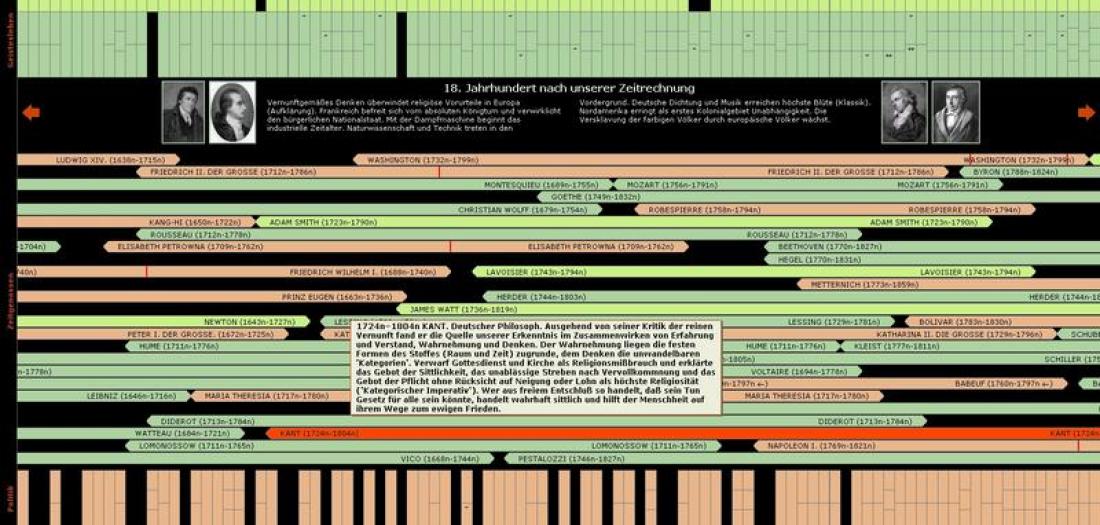The "Digital Peters": The largest world map of the time is now available on DVD
New research and networking functions added
24.08.2010 | General, Project News

To understand history you have to see it. For this reason, Arno Peters (1916-2002´) created a two-volume table work in atlas format in collaboration with numerous renowned specialist scholars: the synchronous optical world history, in which the broad lines and connections of world history were shown for the first time using a new method of representation. It was particularly important to Peters to make the simultaneity and the sequence of historical events visible. All countries in the world, all social classes, all subject areas. Readable for every single year, from the beginning of historiography and human history to the Internet today. It was guided by the idea that "human inadequacy and negligence, but also whitewashing and intent to deceive, falsify our historical-geographical view of the world." Peters searched for and found a new way of writing history: analogous to the map, he developed the time map: parallel to one another and color-coded, events from the economy, intellectual life, religion, wars and revolutions run off. You can see the structure of time, just as you can see the structures of countries and continents with a map at a glance. The first edition of the synchronous optical world history (1952), which was made in a complicated manner and was very expensive for the time, found 250,000 enthusiastic readers, licenses in 43 countries followed. But Peters, who wanted to break the narrow boundaries of traditional regional historiography with his work, finally came up against the limits of the printed book.
Therefore, in a three-year cooperation between Büro-W (Wiesbaden) and the competence center for electronic cataloging and publication processes in the humanities at the University of Trier, the digital Peters book edition on DVD-ROM has been further developed, supplemented by new research and networking functions published electronically together with the original Peters card index. This makes "Der Digitale Peters" the continuation of the famous book with modern means. Every topic of world history can now be explored more easily than ever before. On the time cards, individual years can be grouped into cycles, different types of events (war and revolutions , Social order, intellectual life, economy and technology), major world historical events and the lifetimes of historical figures under the microscope in over 1,100 synchronous optical panels. Every event and every personality can be called up with all its connections. How closely and in what way other data linked to an event is visible at a glance. With the research function, the entire database can also be systematically searched. Thanks to a semantic link, related aspects are also always fanned out during research, which in the adjoining keywords of this 9.0 00 words of comprehensive vocabulary are discussed. Then there are the tools with which over a hundred people worked for several decades on the first edition: a huge card index with around 45,000 Din-A6 cards, full of historical information.
In cooperation with the Central and State Library Berlin, the entire card index was digitized and linked annually with the data records in the "Digital Peters" so that you can now leaf through around 60,000 chronologically ordered scans and search for the sources from which Peters drew. The version of the synchronous optical world history available electronically since March 2010 has the great potential to remain current and to be supplemented, because the story does not end with the 20th century. An expansion of the "Digital Peter" is already being planned. In addition to opening up the system for personal configuration of the database, it should be supplemented by a geographical component in order to be able to visualize both temporal and spatial proximity.
Contact:
Dr Thomas Burch
Kompetenzzentrum für elektronische Erschließungs- und Publikationsverfahren in den Geisteswissenschaften Universität Trier
Fachbereich II/Germanistik
Universitätsring 15
54286 Trier
Tel. 0651/2013364; E-Mail: burch uni-trier.de (burch[at]uni-trier[dot]de)
uni-trier.de (burch[at]uni-trier[dot]de)
Link: Homepage of the project

